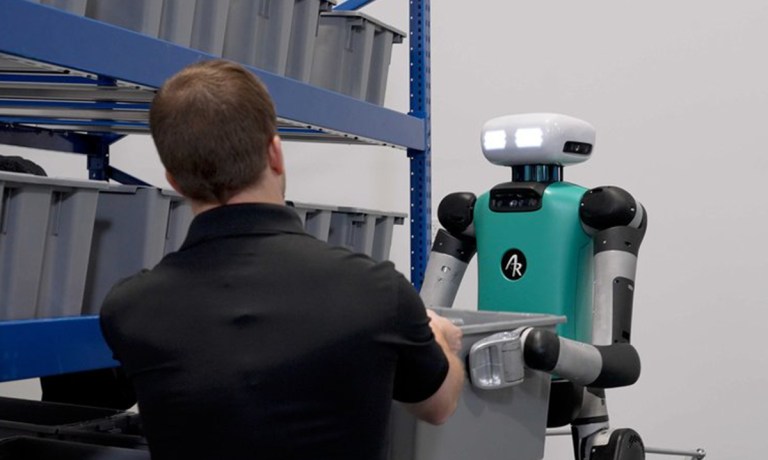
Within every dreamt-up human future, there have always been robots.
Outside of flying cars, no other sci-fi fabrication so firmly places a scene in the “future” as the presence of walking, talking, human-shaped robots.
Now, Hollywood directors and science fiction authors are going to have to come up with something new — because humanoid robots are already here.
Per a Wall Street Journal (WSJ) report, a new generation of autonomous robots is transforming fulfillment operations by helping fill labor gaps in logistics operations.
While savvy warehouse operators have been integrating automated solutions and autonomously guided vehicles (AGVs) into their fulfillment processes for years to drive efficiencies by augmenting and accelerating product sorting, retrieval, and distribution, an emergent class of bipedal and increasingly human-like industrial robotic devices represents something new.
That’s because, similar to how generative artificial intelligence (AI) represented a phase shift forward from the machine learning (ML) capabilities of earlier predictive AI solutions, humanoid robots offer a brand new way for operators to speed up their logistics operations beyond the already-embedded disembodied arms, automated storage, moving trays and other machines currently being used to modernize back-end operations.
Read More: GPT Takes the Manual Out of Labor in the Industrial Economy
Robotic solutions for warehouse tasks are a greenfield opportunity area — one that is already beginning to shift the balance of power in fulfillment centers from machines supporting people to people supporting machines.
But a major pain point for firms looking to integrate warehouse automation is that frequently, integrating an all-new technical architecture to support the fulfillment solutions requires a ground-up redesign of their current facility.
While some companies have gone all-in on building entirely automated dark warehouses, this entails deploying tens of millions of dollars in capital expenditures — and can be difficult to pull off for businesses who are only leasing their space and do not own their warehouses outright.
Firms wary of integrating future-fit automated solutions often cite the heavy technical and capital expenditure lift, but by taking a strategically tiered-and-timed approach to onboard next-generation automated technologies, businesses can manage the evolution in a lock-step fashion that consistently adds both operational and labor-saving value.
Still, the in-operable design of legacy facilities, as all as the long return on investment (ROI) when compared to most three-to-five-year lease terms for logistics facilities and distribution warehouses, continues to serve as a major barrier to the uptake of automation for all but the largest players.
And the largest players are increasingly taking advantage of robotic automation’s benefits to drive further competitive advantages.
As reported by PYMNTS, Walmart has opened its second Market Fulfillment Center (MFC) powered by a proprietary storage and retrieval system leveraging Alphabot, a system that uses autonomous carts to retrieve items ordered for online grocery.
That’s why robotics firms like Agility Robotics, Figure AI and Boston Dynamics, all of which were cited in the WSJ report, are hoping that humanoid robotic devices purpose-built for warehouse tasks can help fill the gap for smaller or more hesitant firms looking to remain competitive in an increasingly autonomous environment without having to bet it all on future-fit architecture.
See also: Firms Grow Profits, Cut Costs with Three F’s of Automation
“Where we’ve had success is on the services side of robotics, in the logistics and warehouse space where [the robots] can do repetitive tasks like a human,” Austin Noronha, managing director U.S. at Sony Ventures, told PYMNTS.
While warehouse operators and logistics firms aren’t too picky about the type of robots they use, as long as they can get the job done cheaply and safely, eliminating the need to redesign existing facilities to support the machines’ capabilities remains priority number one for many businesses.
That’s why multipurpose autonomous robots that can operate efficiently in human spaces without the need for an infrastructure remodel offer such an attractive opportunity.
The ability for robotic solutions to step into existing infrastructure and support existing workflows with minimal modification to the operating environment is a valuable one.
Increasingly, these humanoid devices can do everything that a human can — such as picking and packing orders, unloading trucks, and unpacking pallets of shipments.
Still, as PYMNTS has written previously, it is important to view the tools of tomorrow as a way to accrue efficiencies across existing processes rather than as a total nuts-and-bolts replacement that throws the baby out with the bathwater.
After all, no matter their labor-saving value, even futuristic humanoid robots will need breaks to (literally) recharge.